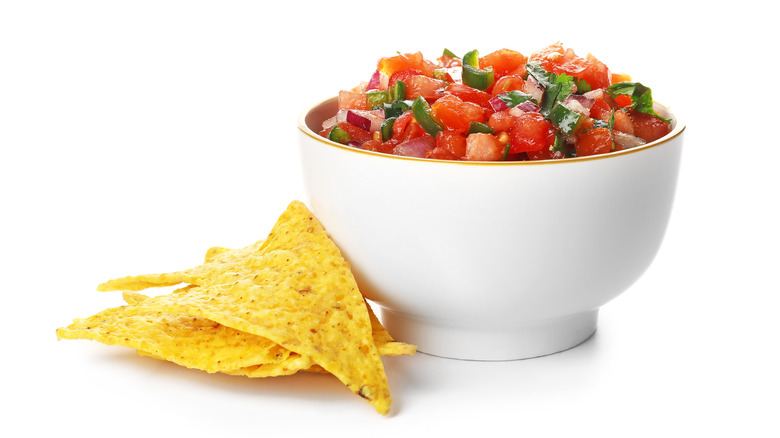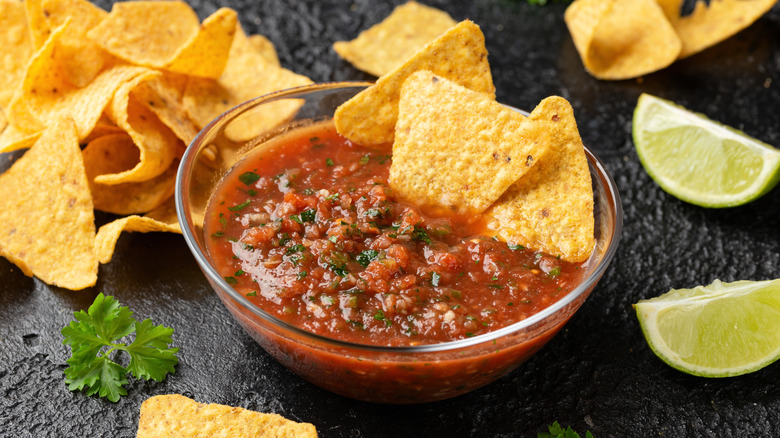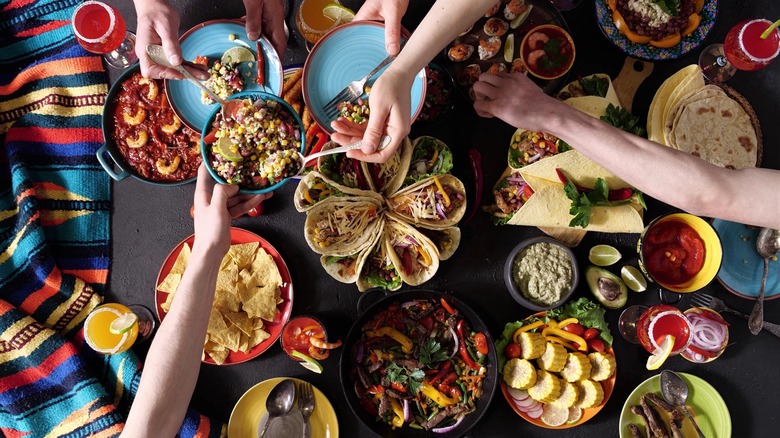The Traditional Difference Between Salsa And Pico De Gallo
Salsa and pico de gallo are staples at virtually any Mexican restaurant you walk into. If one doesn't appear on your table alongside a basket of tortilla chips while you're scanning the menu, chances are you'll be offered some with your plate of tacos and enchiladas. Yet, while they look similar and are often used interchangeably, salsa and pico de gallo are technically two separate and different condiments.
Salsa is generally made with tomatoes, onions, lime juice, garlic, cilantro, and hot peppers. But there are also countless versions like salsa verde (made with tomatillos) and salsa brava, which is smoky and spicy. Other ingredients can be added like corn and beans, and the tomatoes used to make salsa can be fresh or canned, or a combination of both. Salsa is also pureed or partially pureed to make it thinner and to allow the flavors to combine together.
Pico de gallo, on the other hand, is always made fresh and should be served fresh. With the right tomatoes, along with onions, lime juice, chiles, and cilantro, it's less runny and chunkier than salsa because it's not pureed. Whereas salsa can be made in a number of different ways, pico de gallo is pretty much made with the same standard ingredients.
Both salsa and pico have ancient roots
Both salsa and pico de gallo can be traced back to the ancient Aztec, Incan, and Mayan civilizations. The Aztecs of modern-day Mexico were the first people to farm tomatoes, which went into sauces, or "salsas." But all three cultures used tomatoes plentifully, as well as things like squashes, chiles, and beans to make the condiments. Word of such sauces didn't begin to spread until the Spanish invasion of Mexico in the 1500s, and it was a Spanish Franciscan missionary and linguist named Alonso de Molina who actually coined the term "salsa" in 1571.
Pico de gallo is also known as salsa bandera, which means "flag salsa" because its colors of red, green, and white resemble the colors of the Mexican flag. The name "pico de gallo" itself means "rooster's beak." There are several theories as to why the fresh condiment is so named, including that it resembles chicken feed; that the traditional serrano peppers it's made with are shaped like a rooster's beak; and that it was originally eaten with the thumb and forefinger which, when put together, make the triangular shape of a beak.
Use both as tasty toppers for countless dishes
Salsa and pico de gallo can be used to top a variety of Mexican foods. They each make tasty tortilla chip dips, although some would argue that the extra liquid in salsa makes it a better option for scooping. They both taste good at room temperature or cold, but if you want to top a warm food with one and you don't want your food to cool down, consider salsa. For example, if you want some extra flavor on your cheese omelet, spoon some salsa into the skillet you've just used just long enough to take the chill off and pour it over your breakfast.
Though pico de gallo and salsa are technically different, you can use either one to top tacos of all kinds, burritos, nachos, tamales, enchiladas, quesadillas, and tostadas, as well as rice and beans. Spoon some in your soups, on hamburgers, over fish and chicken, on top of your mac and cheese, and over your avocado toast.
If you want to swirl some into sour cream, cream cheese, or mayonnaise-based dips, salsa is the better option because of the extra liquid that will incorporate better. Still, both are fresh, delicious, and nutritious condiments to keep handy for countless dishes and uses.



